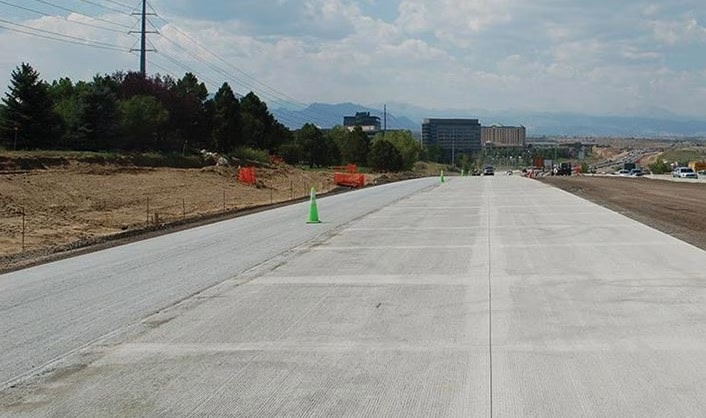Rigid pavement uses concrete as the primary material for its surface, offering exceptional strength and durability. It is designed to distribute the traffic load efficiently, reducing stress on the underlying layers. Known for its high strength, long lifespan, and minimal maintenance requirements, rigid pavements are ideal for areas with heavy traffic or challenging environmental conditions.
Advantages of Rigid Pavement:
- High durability and long lifespan.
- Requires minimal maintenance over time.
- Less prone to cracking and deformation.
- Provides a smooth and stable driving surface.
- Can handle heavy traffic loads efficiently.
- Offers resistance to weathering and extreme conditions.
- Reduces the need for frequent repairs.
- Strong load distribution capabilities.
- Less susceptible to rutting compared to flexible pavements.
- Supports heavy construction and industrial vehicles.
- Improves safety by offering better skid resistance.
- Allows better water runoff, reducing water damage.
Rigid Pavement Layers
Rigid pavements are typically composed of several layers, each playing an important role in ensuring the overall strength and durability.
- Surface Course: This is the top layer of the rigid pavement, typically made from high-strength concrete. It is designed to bear the weight of traffic, withstand wear from vehicles, and provide a smooth driving surface. The surface course is subjected to the greatest amount of stress and is designed to resist cracking, rutting, and deformation caused by traffic loads and environmental factors.
- Base Course: Positioned directly beneath the surface course, the base course serves to distribute traffic loads more evenly across the subbase and subgrade. This layer is typically composed of high-strength materials like crushed stone, gravel, or crushed rock. Its role is to provide additional structural support and help prevent the surface course from cracking or shifting due to pressure or heavy loads.
- Sub-base Course: The subbase lies beneath the base course and provides further load distribution. It also helps improve drainage by allowing water to flow through it, preventing water accumulation under the pavement. Made from lower-strength materials compared to the base course, the sub-base provides a cushion between the stronger layers and the natural subgrade, reducing the risk of deformation and maintaining the integrity of the pavement structure.
- Subgrade: This is the bottom layer of the rigid pavement structure, consisting of natural soil or rock beneath the pavement. The subgrade provides the foundation for all the upper layers and plays an important role in the overall strength and stability of the pavement. Its condition, including its load-bearing capacity, can significantly impact the performance of the entire pavement system.

Types of Rigid Pavement
- Plain Concrete Pavement (PCC): Plain Concrete Pavement (PCC) is the most basic form of rigid pavement, made from a simple mix of cement, water, and aggregates without any reinforcement. This type of pavement is primarily used in low-traffic areas such as local streets and parking lots, where the structural demands are minimal. Although cost-effective and easy to install, PCC is prone to cracking under heavy traffic loads or extreme temperature changes, making it less suitable for high-traffic areas. The absence of reinforcement means that its longevity is dependent on the quality of the concrete mix and the pavement design.
- Reinforced Concrete Pavement (RCC): Reinforced Concrete Pavement (RCC) incorporates steel reinforcements (such as steel bars or mesh) within the concrete to improve its strength and crack resistance. The addition of reinforcement helps the pavement withstand higher traffic loads and resist cracking due to tensile stress. RCC is commonly used in medium to high-traffic applications, such as urban roads and highways. It is more durable and resilient than PCC but requires more time and labor for installation due to the placement of steel reinforcement.
- Prestressed Concrete Pavement (PCP): Prestressed Concrete Pavement (PCP) involves pre-stressing the concrete with tendons or cables before it is placed, which increases the pavement’s ability to resist tensile forces and cracking. This type of rigid pavement is designed to handle heavy loads, making it ideal for use in high-traffic highways and industrial areas where pavement strength is needed. PCP offers enhanced durability and longer service life due to its resistance to stress and cracking, but it requires specialized equipment and expertise for installation, making it a more expensive option than other types of pavements.
- Jointed Plain Concrete Pavement (JPCP): Jointed Plain Concrete Pavement (JPCP) features concrete slabs that are separated by joints, typically spaced at regular intervals to accommodate the expansion and contraction of the pavement due to temperature changes. These joints allow the pavement to expand and contract without causing cracks, enhancing its durability. JPCP is often used in highways and roads with moderate to high traffic volumes, as the joints help to control the formation of cracks while maintaining a smooth and stable surface.
- Jointed Reinforced Concrete Pavement (JRCP): Jointed Reinforced Concrete Pavement (JRCP) is similar to JPCP but includes steel reinforcement to provide additional strength and reduce the likelihood of cracking. The reinforcement helps control the distribution of stresses across the pavement, especially in areas with higher traffic loads. JRCP is ideal for roads and highways where heavy traffic and temperature fluctuations could cause significant damage to plain concrete. The inclusion of reinforcement allows for larger slab sizes, reducing the number of joints and resulting in a smoother ride. Like JPCP, proper joint design and sealing are important to ensure its effectiveness.

Applications of Rigid Pavement
- Highways and Expressways
- Airports and Runways
- Industrial Roads
- Urban Streets
- Ports and Marine Infrastructure
- Parking Lots
- Bridge Decks
- Cement Plants and Mining Roads
- Military and Defense Roads etc.
Conclusion
Rigid pavements offer durability, strength, and low maintenance, making them a dependable choice for high-traffic areas.. As construction technology advances, rigid pavements continue to play an important role in road infrastructure.


